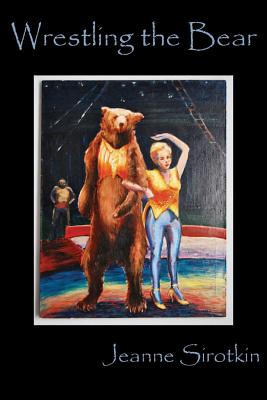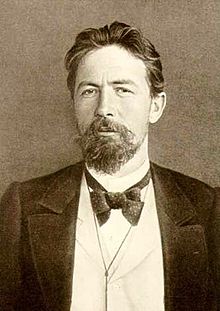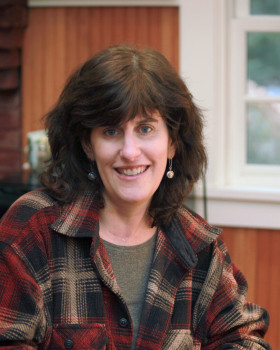Jeanne Sirotkin’s stories are full of mystery and surprise. In “Renegade,” set in the near future, an outlaw organ donor meets his true love only to have her lure him into a trap: not only must he give up his internal goods, he’ll also have to track down fellow renegades like himself until he has paid his debt to society. In “Weather,” an amateur storm-spotter hooks up with a real meteorologist for a whirlwind romance. And in “Thomas Edison’s Last Breath,” a writer meets her muse. He’s squat, hairy, smokes cigars, and has a distasteful sensibility. But that doesn’t make him wrong.

Jeanne began her writing life as a poet in the 1960s. A few decades later, she began writing fiction. Her short story collection, Wrestling the Bear, won the 2011 Stephen F. Austin Press Prize in fiction and was published in February, 2013. In a series of email exchanges, Jeanne and I discussed the relationship between poetry and fiction, the “awareness of the marvelous,” and the role of epiphany in her work.
Interview:
Danielle LaVaque-Manty: How did you learn to write? Did you study writing in school, at workshops and conferences, in writing groups, or on your own?
Jeanne Sirotkin: I came to poetry in the late sixties through music, through a fascination with singer-songwriters in particular. I realized that the lyrics themselves were music and since I couldn’t sing but three notes (and they all sounded the same), I started to write. Probably the greatest influences were Leonard Cohen and Bob Dylan.
I moved to San Francisco in 1969, after four truncated college attempts, by hopping into an Austin America and driving west. The car was famous for its short life. It had a fatal design flaw that made it stall in the rain. When I left the Midwest (I was born and raised in Detroit) I had never been further west than Chicago and was in awe of California. I’d never seen a palm tree and fell in love with the ocean and with the bohemian scene of North Beach.
This was the time of the great poetry renaissance. Readings and magazines abounded. Three of us edited a one-shot magazine from the Coffee Gallery of North Beach—The San Francisco Gallery Magazine. We printed poetry and art. At that time visual artists and writers shared a common scene. We had a group of about a dozen people who called themselves “The Parachute Salon.” We’d gather once a month to eat stupendous food and read aloud our work in progress and offer critique. Three or four visual artists also participated.
I took classes at San Francisco State while I worked, in order to finish my degree in creative writing. Wonderful writers taught there during those years. Stan Rice was one of my advisers. Nanos Valaoritis (the Greek surrealist) was a great influence, along with Kay Boyle, Robert Creeley and others. Nanos gave me the line that became the title for my chapbook, “An Unzipped Dress.” He shook a finger at a bunch of us one day and said, “Time is measured by an unzipped dress.”
Tell me more about that chapbook.
It was published after Harold Graves heard me read and asked for a manuscript. He was resurrecting his beatnik Golden Mountain Press following a heart attack. That year, 1975, he published three wonderful chapbooks—one by Jack Hirschman, one by Luke Breit, and mine.
It was quite the time—Andrei Codrescu, Jim Gustafson, Kathy Acker, Robert Gluck, Ntozake Shange, Jessica Hagedorn—these were some of the people who we read with regularly. Bob Kaufman was in his silent phase, protesting the Vietnam war, when I arrived, and I remember one night after the war ended when he stood up to read in the Coffee Gallery in North Beach and with a rusty, creaky voice spouted incredibly intense, blinding verse.
Am I right in thinking you focus more on fiction than on poetry now? What led to that transition? And how do you balance the two?
I didn’t have much time to dwell in the What If world of prose writing until I taught creative writing at the Roper School, a high school in Birmingham, Michigan for gifted students, from 1992-2002. I founded their writing program and revived their dormant literary magazine. After nine years, I found I wasn’t doing much of my own work. I took a year’s sabbatical and never went back. That first year I started twenty-two stories, writing in a frenzy of clogged creativity. Of course, most of them didn’t survive. The transition involved many workshops (Sewanee, Aspen, Indiana) and a writing group. I had the strange experience of having to learn to unbundle and de-condense my work. Most of the writers I worked with had the opposite issue—having to cut, chop, cut. I spent a decade teasing out my stories.
In poetry, huge immense time/space/pictures/emotions are contracted into small tight packages. Squeezed, as it were. I like to think of coal to diamond. With fiction, a writer takes a kernel—a character, a scene, an idea—and runs with it. It grows and branches and expands into the form that it needs.
This is almost like the difference between being right-handed and left-handed in terms of brain function. Consequently writers have a preference. There are ambidextrous writers also.
I still write poetry, especially in stalled moments when I need to step away from a prose piece I am working on, particularly novel writing. Or during an emotional time, when I need an instant sort of outlet. I do still send poems to my friends, my family, people I love.
I know you believe there is a fine line where less is more in terms of style. What are your thoughts on how to tread that line?
Poetry has been a blessing to my prose. I always admired Lorca. Robert Bly talked about how Lorca’s poetry works. He called it “leaping”—that is the way in which a writer progresses from point A, B, C, D, E without touching down at each point. In a good leap a writer can take the reader flying with him from point A to C to E. It is that exhilaration of flight that makes a reader catch his breath and exhale in satisfaction. That becomes the fine line where less is more in terms of style.
This translates into prose. When we are writing in scene, all detail and sensory data are important, but we can shift scene, point-of-view, etc. and move and carry the reader with us, when the leaping in prose is done successfully. Successful means seamless, when it feels natural. This is like in our ordinary world when we jump over a step. The landing has to support the reader. The reader may not have to know how we got to “there”—it may be only a thin thread carried invisibly. In “Wrestling the Bear” Bert intuits what to do in order to pin the bear, through a vision. How this comes to him isn’t important. It comes from that mysterious place where part of all of us dwells.
The stories in Wrestling the Bear include a lot of fabulist or surreal elements—wrestling that bear in the title story, some slippage in time in “Carnavale,” the merging of cat and human traits in “Feline Domesticus,” among many other examples. How do you think about the relationship between the real and the fantastic in your work?
The line between the real and the unreal world is my favorite place to write from. I think of it as a narrow path between two valleys. On one side is the concrete real world and on the other side is the unreal (sometimes this is surreal, sometimes fabulist, sometimes a mere altered sense of time). It is from that place that is neither real nor unreal that I want to write. I think it is the place that I inhabit and live most of my life. One writer who does this so well is George Saunders. His stories tread that line deftly.
Talk to me about epiphanies and redemption. Do you believe in them?
Our world is filled with small epiphanies—all of those aha! moments. My characters find, trip, stumble into those moments, which we in our daily lives are often too busy to acknowledge. This is one thing that writing brings us all—an awareness of the marvelous. It is a place inhabited by artists. Vincent Van Gogh once said in a letter to his brother Theo (not an exact quote here), “I have moments of terrible lucidity when nature is so glorious, in those days I am hardly conscious of myself and the pictures come to me as in a dream.”
I believe in a world that is a complex web of synchronistic events. Some people are more comfortable thinking of these as coincidences. We all know those strange moments when paths cross, when we have a déjà vu, when we compare notes and find out that the person we are talking to has been everywhere we have been, but maybe one day behind us. Using this in writing blurs the line between real and unreal and causes our characters to have little bursts (small epiphanies) of recognition about themselves or their worlds.
And I believe in redemption. Not the kind that invokes “they lived happily ever after.” Redemption doesn’t mean that you are saved. It means that the epiphanies have led to an action. “Leisure World,” the last story in Wrestling the Bear, ends with Sue Anne rescuing her grandfather from a strip club, seeing him in her mind’s eye as a young man, and letting him mistake her for his dead wife. Sue Anne really understands something deep and profound about her grandfather in that moment, and I wish I could have understood my own grandparents in that way. Maybe that’s why I wrote it. I didn’t set out that way or with that intention. It just happened.
Yours is not a collection of linked stories, for the most part. So I’m wondering about Donald, in “Lot 23,” who makes his first appearance in “Motor City Caper.” Did you write “Lot 23” because you wanted to find out what happened to Donald? Or did you figure out that the main character in that story was Donald while you were writing it?
Donald is really interesting to me because he was in my first novel. After a couple of drafts, I realized I had too many subplots, and alas he was cut. He needed a home and his story needed to be told in some smaller package. That is always a difficult cut—when you realize that the story being told by the characters is not the story you initially started out to tell. Cut cut cut. I have become ruthless. So Donald took on a new life in the two stories, especially in “Lot 23,” where I try to understand how he committed the crimes that he did. His story is surprisingly a true one that I heard many years ago, like my character did in “Motor City Caper,” at an orthopedic convention in Toronto. (My husband is a surgeon.) I am satisfied with Donald’s existence now.
Many of your stories are set in Detroit, but there are also stories in your collection that are set in South Texas, in Venice, in Louisville, in New York City, and so on. One of the things I love about your work is that I usually know where the stories are taking place, and the place really matters. How do you choose your settings, and how do you think about the relationships between your settings and your characters?
Setting is a character for me. I have lived in California, Colorado, Texas and Michigan and spent large chunks of time in Mexico, New York, and Vermont. So these are familiar places that I can use as characters. I know their details, and it is through detail that a writer particularizes a place. Otherwise I have to turn to the internet. Although I traveled in Italy, I had to roam the Internet to find the places I needed in Venice for “Carnavale.” For my first, unpublished novel, Exit Wounds, I got to actually rather than virtually revisit both South Texas and the state of Veracruz. Here is an example of how, when one starts writing, synchronistic events occur: I had two of my sections set on South Padre Island and in coastal Veracruz. On my trip south, as I drove onto South Padre, a large sign welcomed me, stating that it was a sister city to the city in Veracruz where I had set much of the Mexican portion. Coincidence or synchronistic moment.
Am I right in thinking you’re working on another novel right now? Could you tell me what it’s about? Does it include any surreal or fantastic elements?
I started Exit Wounds in 2005 after a conversation at Sewanee with Richard Bausch. He told me that it sounded like a novel to him. It’s the story of Samantha, a 33-year-old forensic scientist who works in the Detroit morgue doing autopsies and carrying in the dead. Her brother, 31, is a drifter who is in and out of Detroit where their mother lives. The mom is developing early dementia. It is a bit unconventional in that one of the characters meets a woman who is a graphic artist and then several sections start appearing in graphics. I also have a version which has the text for the comics without the graphics.
Now, I am deep in the muck of a first draft of my second novel, the story of an immigrant family in Detroit. It’s set partially pre-WWII (up to Pearl Harbor) and then jumps to the fifties and sixties. It has this cloud hovering over it about identity—what we change when we come here and what we refuse to leave behind. I am not sure yet exactly whose story it is, the mother’s or the daughter’s.
This second novel has several remarkable moments of coincidence, but not as many fantastical moments as the first novel. I like to think both walk the edge of the real world in different ways.
Links and Resources:
- Read Jeanne’s poetry, short stories, and excerpts from her novels on her website.







